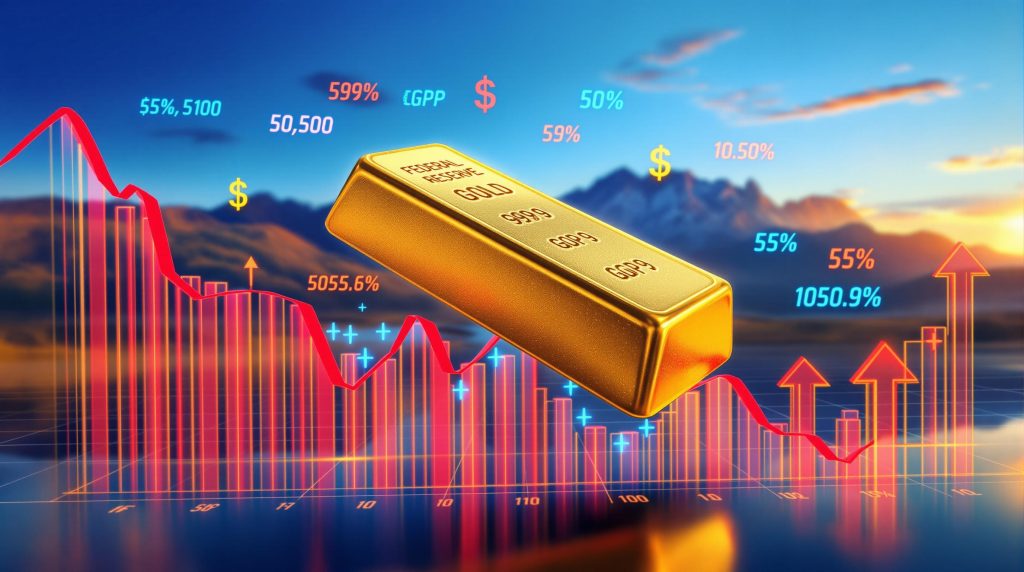How Does Inflation Data Impact Fed Rate Cut Expectations?
Inflation metrics serve as the compass guiding Federal Reserve policy decisions. When consumer and producer prices show specific patterns, markets quickly adjust their expectations for interest rate movements accordingly. This relationship is particularly crucial in today's economic environment, where inflation data directly influences how aggressively the Fed might cut rates.
The interpretation of inflation data isn't straightforward – it requires understanding how the Fed balances its dual mandate of price stability and maximum employment. Markets parse every decimal point in CPI and PPI releases, looking for signs that might influence the timing and magnitude of potential rate cuts.
As Matthew Bolden from GoldPrice.org notes, "Following on from a deeply disappointing July Jobs Report—which signaled the US economy may be faltering under the pressure of higher interest rates and accordingly tight financial conditions—markets and Fed watchers across the world were looking for inflation pressures to appear mild (if not moderating) enough to further encourage the FOMC to lower policy rates."
When inflation shows signs of cooling, markets typically increase bets on rate cuts. Conversely, hotter-than-expected inflation data can quickly dampen these expectations. This dynamic relationship creates significant market volatility around inflation data releases, particularly in rate-sensitive assets like gold.
The Current Gold Market Landscape
Gold's Price Stability Amid Rate Cut Expectations
Gold has maintained remarkable stability around the $3,335/oz level despite recent economic data releases. This price resilience demonstrates how the precious metal has found a support zone as investors anticipate potential Federal Reserve rate cuts in the coming months.
According to market analysis from GoldPrice.org, gold briefly dipped to $3,330/oz in early Tuesday trading as investors repositioned ahead of inflation data releases. However, buying interest quickly emerged at this level, highlighting the strong support that exists just below current trading prices.
The precious metal's ability to hold steady despite mixed economic signals underscores its appeal as both an inflation hedge and a safe haven during periods of monetary policy transition. This stability is particularly noteworthy given the complex interplay between inflation concerns and economic growth worries.
Key Price Levels and Market Sentiment
The yellow metal has established clear technical boundaries:
- Strong support at $3,330/oz where buyers consistently emerge
- Resistance near $3,400/oz capping upside momentum
- Trading range narrowing as markets await clearer signals
This consolidation pattern suggests investors are positioning themselves ahead of expected monetary policy shifts while carefully weighing inflation data against economic growth concerns.
As noted by Matthew Bolden, "After the yellow metal shed some value at the start of the week, falling to $3330/oz in early Tuesday trading as investors shifted ahead of the CPI release, support has been consistent at that level, with gold still finding eager buyers." He further observed that "there has been no notable attempt to push the precious metal's price back towards $3400."
This price action reveals a market in equilibrium – not panicking about inflation, yet cautiously optimistic about potential rate cuts. The narrowing trading range indicates a potential breakout once clearer policy signals emerge.
What Recent Inflation Data Reveals
July CPI: Mixed Signals for Rate Cut Prospects
The July Consumer Price Index provided a nuanced picture for market participants. According to analysis from GoldPrice.org, July's CPI numbers came in slightly below expectations, which was viewed as accommodative for rate cut expectations.
However, the core CPI figures – which exclude volatile food and energy prices – crept higher on both a monthly and annualized basis. This divergence between headline and core inflation metrics created a mixed picture for investors trying to gauge Fed policy direction.
| CPI Metric | July Result | Market Expectation | Impact on Rate Cut Odds |
|---|---|---|---|
| Headline CPI | Slightly below forecast | Moderate cooling | Positive |
| Core CPI (Monthly) | Small increase | Stable | Neutral |
| Core CPI (Annual) | Modest rise | Stable | Neutral |
These figures suggest inflation pressures remain persistent but aren't accelerating dramatically, keeping September rate cut expectations intact without strengthening the case for multiple cuts.
Producer Price Index: A Warning Signal?
Thursday's PPI release delivered a more concerning inflation outlook. According to the GoldPrice.org report, the headline PPI figure showed a month-over-month increase of +0.9%, well above market expectations.
This substantial jump in producer prices could signal:
- Early impacts from new tariffs impact markets affecting import costs
- Supply chain adjustments creating cost pressures throughout production systems
- Potential pass-through to consumer prices in coming months, which could complicate the Fed's rate cut calculus
As Matthew Bolden noted, "The Producer Price Index output for the same month, printed on Thursday morning, was less supportive of projecting interest rate cuts. The headline number showed PPI—the cost of raw materials used to produce goods—coming well above expectations at a month-over-month rate of +0.9%."
The divergence between CPI and PPI creates a complex picture for Fed officials. While consumer inflation appears to be moderating slightly, producer costs are rising significantly, which could eventually work its way into consumer prices.
How Markets Are Interpreting Fed Rate Cut Possibilities
Current Rate Cut Probabilities
Market pricing currently reflects specific expectations for Federal Reserve action based on the latest inflation data and economic indicators. The consensus view appears to favor a measured approach to monetary easing.
Based on market reactions to recent data:
- September: High probability of a 25 basis point cut remains intact despite PPI surprise
- December: Expectations for 2-3 total cuts by year-end, though with decreasing confidence
- Early 2026: Growing uncertainty as markets weigh inflation persistence against economic weakness
The gold market performance suggests that a September rate cut is largely priced in, with Matthew Bolden noting, "Trading on Tuesday held gold relatively flat, implying that July CPI makes the case for a cut by the end of September, yes—but that this projection is fully priced in."
Why Are Markets Shrugging Off PPI Surprise?
Despite the alarming PPI figure, markets have shown limited reaction, suggesting:
- Investors believe the Fed will proceed with at least one rate cut regardless of modest inflation concerns
- Markets view the PPI spike as potentially temporary rather than the start of a new inflation trend
- Economic growth concerns are outweighing inflation worries in the Fed's decision-making calculus
- Traders are waiting for more definitive signals from Fed officials, particularly at the upcoming Jackson Hole symposium
As reported by GoldPrice.org, "The immediate market reaction to the upside surprise in producer prices was generally tepid as well, suggesting that investors don't expect the data set to scuttle expectations for at least one Q3 cut."
This market behavior reflects a sophisticated understanding that the Fed weighs multiple factors beyond a single inflation reading. It also indicates that growth concerns may be taking precedence over inflation fears in the current economic environment.
What's Driving Gold's Current Trading Pattern?
Gold's Response to Economic Indicators
Gold's price movements this week revealed specific market dynamics that provide insights into investor sentiment regarding inflation data and fed rate cut bets:
- Initial weakness: Prices dipped to $3,330/oz early Tuesday as investors positioned ahead of CPI data, demonstrating caution before key economic releases
- Stabilization: Support held firmly after inflation reports, indicating that the data was largely in line with rate cut expectations
- Limited upside: No meaningful push toward $3,400/oz despite rate cut expectations remaining intact, suggesting a fully-priced market
- Consolidation: Trading in a narrow range as markets digest mixed signals from CPI and PPI reports
This price action reveals a gold market that is neither panicking about inflation nor euphoric about rate cuts. Instead, it suggests a cautious optimism that at least some monetary easing is coming, while acknowledging the risks posed by persistent inflation pressures.
The Balancing Act Between Rate Cuts and Inflation
Gold investors are weighing competing factors:
- Supportive: Expectations for lower interest rates later this year boost gold's appeal as a non-yielding asset
- Limiting: Concerns that inflation could remain sticky, potentially delaying multiple cuts beyond the first move
- Uncertain: Impact of tariff policies on future price pressures, which could complicate the Fed's easing path
This balancing act explains gold's recent consolidation pattern. With the September rate cut widely expected but future cuts less certain, investors are waiting for clearer signals before making larger directional bets.
The relationship between inflation data and fed rate cut bets remains the central focus for gold traders. As new data emerges, market participants will continue to adjust their expectations for both the timing and magnitude of potential Fed easing.
The Critical Role of Jackson Hole Symposium
What Investors Are Watching For
The upcoming Federal Reserve economic symposium at Jackson Hole represents a pivotal moment for markets. This annual gathering of central bankers and economists provides a platform for significant policy signals that could resolve current market uncertainties.
According to Matthew Bolden of GoldPrice.org, "With the Kansas City Fed's annual Jackson Hole Symposium kicking off on Friday with the usual keynote address from the Chair of the Fed, we can expect Jerome Powell & Company to send meaningful signals about how they expect inflation pressures, among other key macroeconomic inputs, to influence monetary policy for the next 3 to 6 months."
Market participants will be focusing on:
- Fed Chair Powell's keynote address for explicit guidance on rate cut timing
- Officials' interpretation of the divergence between CPI and PPI data
- Any shifts in the Fed's risk assessment between inflation concerns and growth risks
- Potential signals about the pace and extent of the easing cycle once it begins
The symposium comes at a crucial juncture, with markets having largely priced in a September cut but uncertain about subsequent policy moves. Clear guidance could resolve this uncertainty and potentially trigger a breakout in gold prices.
Historical Impact of Jackson Hole Signals
Previous Jackson Hole symposiums have frequently served as platforms for major policy announcements or shifts in Fed thinking. This historical precedent makes the event particularly significant for gold investors and rate-sensitive assets.
The symposium's timing – after recent inflation data but before the September Fed meeting – positions it perfectly for officials to provide forward guidance that incorporates the latest economic information. This guidance typically has an outsized impact on market expectations and asset prices.
For gold investors, Powell's speech could be the catalyst that resolves the current trading range. A clear dovish signal could drive prices toward or beyond the $3,400/oz resistance level, while a more cautious approach that emphasizes inflation concerns might test support levels.
How Economic Weakness Factors Into Rate Decisions
July Jobs Report Implications
The disappointing July employment report has created a complex backdrop for Fed decision-making. As referenced by GoldPrice.org, this report signaled that "the US economy may be faltering under the pressure of higher interest rates and accordingly tight financial conditions."
This economic weakness strengthens the case for monetary easing despite inflation concerns, creating a favorable environment for gold. The Fed's dual mandate requires balancing price stability with maximum employment, and signs of labor market deterioration increase pressure to reduce rates.
The combination of a weakening jobs market and mixed inflation signals creates a delicate balancing act for Fed officials. Markets are watching closely to see which concern takes precedence in policy deliberations.
This context explains why markets have maintained rate cut expectations despite the PPI surprise. Economic weakness provides a compelling rationale for easing monetary policy, even if inflation hasn't fully returned to target levels.
The Growth-Inflation Tradeoff
Central banks typically face a tradeoff between supporting growth and containing inflation. The current economic landscape features:
- Signs of economic slowdown in employment data
- Persistent but not accelerating consumer inflation
- Concerning jumps in producer prices that could work through the system
This combination creates a challenging policy environment where the Fed must weigh the risks of moving too quickly (potentially reigniting inflation) against moving too slowly (potentially deepening economic weakness).
Gold's traditional role as a safe haven during economic uncertainty makes it particularly attractive when growth concerns are rising. If the Fed signals that growth worries are taking precedence over inflation concerns, gold could see increased investment demand.
Investment Strategies Amid Policy Uncertainty
Portfolio Positioning for Rate Cut Scenarios
Investors are adopting various approaches to navigate the current environment:
- Maintaining gold allocations as a hedge against policy mistakes, recognizing that the Fed faces a difficult balancing act
- Watching for breakout signals above $3,400/oz if Fed rhetoric turns decisively dovish at Jackson Hole
- Monitoring inflation expectations for signs of persistent price pressures that could limit the Fed's ability to cut rates
- Preparing for potential volatility around key Fed communications, particularly Powell's Jackson Hole speech
The relationship between inflation data and fed rate cut bets creates both risks and opportunities for investors. Those who correctly anticipate how the Fed will interpret economic data can position their portfolios advantageously ahead of policy shifts.
In the current environment, a balanced approach that includes inflation hedges like gold alongside traditional assets may provide protection against policy uncertainty while maintaining exposure to potential upside if rate cuts materialize as expected.
Technical Indicators to Watch
Several key technical factors may signal gold's next directional move:
- Trading volume patterns around the $3,330 support and $3,400 resistance levels
- Momentum indicators suggesting potential breakout conditions if policy signals clarify
- Correlation with Treasury yields and dollar strength, which often provide early signals of changing rate expectations
These technical factors, combined with fundamental analysis of Fed communications and economic data, can help investors identify potential entry and exit points for gold positions.
The narrow trading range currently observed typically precedes a significant directional move once uncertainty resolves. The upcoming Jackson Hole symposium could provide the catalyst for such a resolution, making it a crucial event for gold investors.
FAQs About Inflation Data and Fed Rate Expectations
How does CPI differ from PPI in terms of Fed policy impact?
The Federal Reserve typically places greater emphasis on consumer inflation (CPI) when making policy decisions, as it directly reflects prices paid by households. However, PPI can serve as an early warning system for future CPI movements, as producer cost increases often eventually pass through to consumer prices.
The recent divergence between moderating CPI and accelerating PPI creates a policy dilemma. While current consumer inflation supports rate cuts, rising producer costs raise questions about future inflation pressures. The Fed must balance these competing signals in its policy decisions.
Why hasn't gold broken higher despite rate cut expectations?
Gold appears to have fully priced in the expectation of at least one rate cut by September. For prices to move significantly higher, markets would need to see either: 1) expectations for more aggressive rate cuts, 2) signs of economic deterioration, or 3) heightened geopolitical concerns.
As Matthew Bolden observed, gold trading has been "relatively flat, implying that July CPI makes the case for a cut by the end of September, yes—but that this projection is fully priced in." This suggests that current prices already reflect the most likely policy outcome.
Additionally, uncertainty about the path beyond the first cut may be limiting gold's upside potential. Clearer signals about multiple cuts would likely be needed to drive prices significantly higher from current levels.
What would cause the Fed to delay rate cuts despite economic weakness?
The Federal Reserve might postpone rate reductions if inflation data shows persistent upward pressure, particularly if officials believe that cutting rates prematurely could reignite price increases. The recent PPI surge represents exactly the type of data that could give policymakers pause.
Other factors that might delay cuts include:
- Stronger-than-expected consumer spending data suggesting economic resilience
- Wage growth that remains elevated, potentially feeding into service sector inflation
- Financial conditions that ease significantly without Fed action, reducing the urgency to cut rates
- Concerns about asset bubbles forming if rates are reduced too quickly
The balance between these factors and signs of economic weakness will determine the Fed's policy path.
How might tariff policies affect inflation and gold prices?
New tariff policies could create inflationary pressures through higher import costs while simultaneously slowing economic growth—a challenging combination for monetary policy. This "stagflationary" environment typically supports gold prices as both a hedge against inflation and economic uncertainty.
The recent PPI surprise may partially reflect early impacts from changing trade policies. If these effects persist and feed through to consumer prices, they could complicate the Fed's ability to cut rates aggressively, potentially limiting gold's upside in the near term.
However, if tariffs significantly impact economic growth without causing sustained inflation, they could ultimately strengthen the case for rate cuts, supporting gold price forecast over the medium term.
Further Exploration
Readers interested in learning more about the relationship between inflation data and Federal Reserve policy decisions can explore regular market analysis on factors affecting precious metals prices. Understanding how markets interpret economic data and adjust rate expectations is crucial for anticipating gold highs analysis in today's complex economic environment.
The interplay between inflation data and fed rate cut bets will remain a dominant theme for financial markets in the coming months. By closely monitoring both headline numbers and underlying trends, investors can better position themselves for the Fed's evolving policy approach.
Tracking Gold Investments in This Rate-Cut Environment?
Stay ahead of market-moving mineral discoveries with Discovery Alert's proprietary Discovery IQ model, which transforms complex announcements into actionable investment opportunities. Explore how historic mineral discoveries have generated exceptional returns by visiting the Discovery Alert discoveries page and position yourself for the next major market opportunity.




